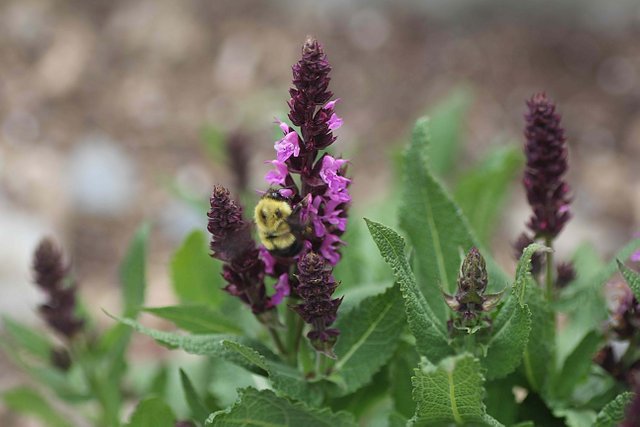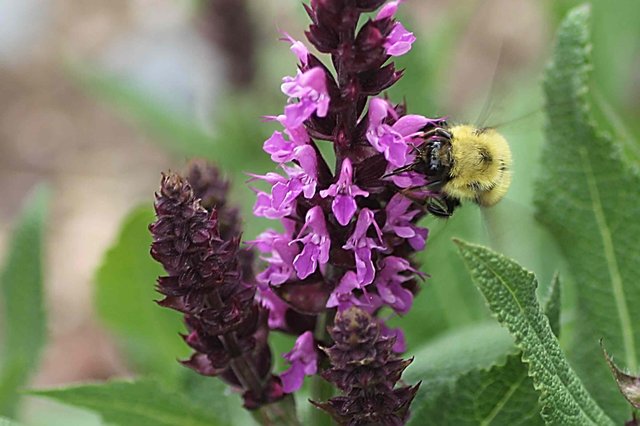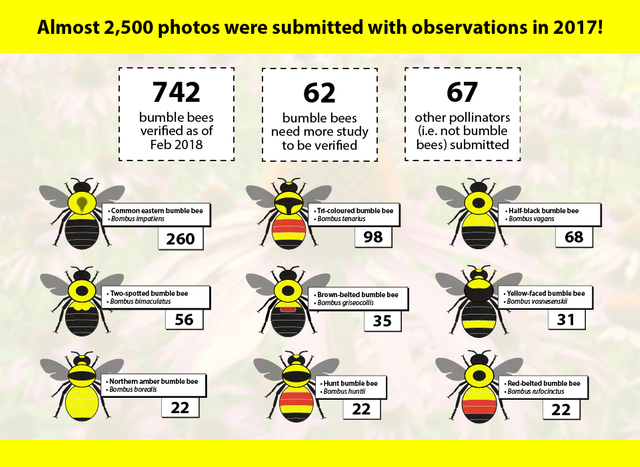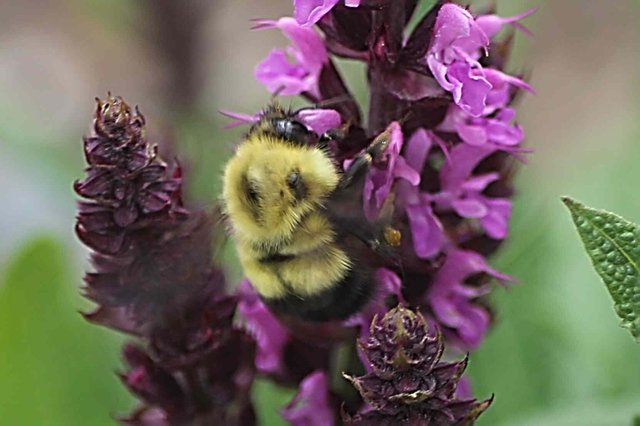The Garden Bumble Bee Count - Join Us!
The bees are back! There's no shortage of pollinators around our homestead and we do what we can to make this a welcoming & safe place.
When they come out of hiding and get to work in the garden, it brings a sense of optimism and promise for the coming harvests.
I've really taken an interest in bees and make sure that we provide the local pollinators with a safe food source. We are without question, a bee friendly homestead. Absolutely no chemicals are used in our gardens, not even organic approved ones. In addition to this we also offer safe habitats around the gardens and plenty of water sources.
A lot of the habitat the bees like best, just creates itself. The wild plants and flowers in the pasture just grow wild and free. They love it and it looks pretty too. We plant many things that bees love (borage, nasturtiums and allow some vegetables to go to seed because bees LOVE that. An oregano patch in flower is a very hot bee hang out! Even our cover crops (buckwheat specifically) make the bees very happy.
The wild Bee reels from bough to bough
With his furry coat and his gauzy wing,
Now in a lily cup, and now
Setting a jacinth bell a-swing,
In his wandering...
~ Oscar Wilde, Her Voice
Tracking the bees
I though it would be educational to track, photograph and try to learn how many different types of bees we have on our property. Is it just one species or many? Are there any honeybees around? I never see any. How can I tell which bee is which?
I found a great resources called "Friends of the Earth’s Great Canadian Bumble Bee Count". From July to August you can send in your findings to help catalogue and gather data on the bumblebee situation. There are similar initiatives in the united states and a few other countries too. They have resources to help identify different bees and tips on how to photograph them which I found quite helpful.
Why It Matters
More than two thirds of the food crops we eat rely on bees and other pollinators to successfully produce a crop. Intensified agriculture, its accompanying loss of habitat, along with the widespread use of pesticides and herbicides, has taken a toll on the bee populations.
We must not let our guard down – we must stay vigilant and insist on enforcement of pesticide bans.
Be careful of the plants you purchase for your garden. Some of them have been found to contain chemicals toxic to bees. Some of our big box stores made commitments to sell bee safe plants. Here's an interesting story where a gardener took it upon herself to have a wide variety of plants tested at the University of Guelph and found shocking and terrible results. http://foecanada.org/en/2018/04/breaking-news-toxics-in-my-garden/
Other Bumble Bee Watches / Organizations
- United states
https://www.bumblebeewatch.org/ - United Kingdom
https://friendsoftheearth.uk/bee-count/great-british-bee-count-bee-identification-guide - Australia
https://wildpollinatorcount.com/2016/02/22/a-pollination-predicament-bumble-bees-and-their-presence-in-tasmania/ - New Zealand
http://www.nzbct.org.nz/ - Canada
http://foecanada.org/en/issues/bumble-bee-count/
 Two spotted bumble bee (I'm pretty sure). I looked at the chart and some photos on-line to help me with identification. It takes a bit of practice.
Two spotted bumble bee (I'm pretty sure). I looked at the chart and some photos on-line to help me with identification. It takes a bit of practice.
Bumble Bees Missing In Action in Canada
Canada already has one officially designated endangered bee: the Rusty-patched bumble bee and there are now six other wild bee species determined to be critically at risk.
Macropis Cuckoo Bee (Nova Scotia)
Western Bumble Bee occidentalis (British Columbia, Alberta and Saskatchewan)
Western Bumble Bee mckay (Yukon, Northwest Territories and British Columbia)
Gypsy Cuckoo Bumble Bee (Canada)
Get your cameras ready!
Lets all take some time to observe and identify the bees in our gardens & neighbourghoods! Spread the word with #bumblebeecount so more people can join in!
Grab your camera, head outside and start looking for bees. Check out some tips for spotting and taking photos of bumble bees!
Record the date and location of your bumble bee sighting. Include other observation( weather, number of bees spotted, flowers etc)
Use an on-line Bumble Bee Identification Guide for your area to help identify the bees.
Share your photos on Stemit, Twitter, Facebook and Instagram using #BumbleBeeCount tag!
Building a greener, more beautiful world one seed at a time.
Homesteading | Gardening | Frugal Living | Preserving Food| From Scratch Cooking|
You can also find me at: walkerland.ca | Facebook
Photo copyright: @walkerland





I have nominated your post for inclusion in the new @curateme list.
You are one of the first posts selected!
This is a brand new project that is just getting going; however, is not
yet fully active. I do hope this helps boost your visibility and
rewards as I have found this to be an article I truly enjoyed!
This is such an important subject, saving the bees.
Steem on, @irishgirl
We loved your great content so much we wanted to showcase it in our weekly curation report where you will be paid from the post payout. Thank you!
You can find the post here;
https://steemit.com/helpie/@helpie/helpie-s-homesteading-curation-report-12-by-helpie-curator-llfarms
oh, wow! Thank you so much.
A vast majority of people fail to realize that without Bee's around we ( the human species ) would be screwed . We would starve to death in a few short years .
If I could swap all our wicked wasps, yellow jackets, and hornets for bumble bees and honey bees, I'd be a very happy woman! I love watching and listening to bumble bees buzzing around, and I've got the kiddos saying "awww, he's so cute!" and stopping to watch them too :)
Do you have issues with wasps? I don't want to use chemical pesticides but since wasps kill bees, I'm eventually going to have to get rid of them somehow if I ever get beehives.
We do have wasps but I would not say they are much of a problem. I leave up old wasp nests and have had fake ones in past which is supposed to make them avoid creating a place there (this keeps them away from the house).
I don't have a lot of knowledge about this and I am not sure what organic/natural bee keepers do, maybe @mountainjewel has some suggestions? It's something I definitely want to learn more about too!
I think you're spot on leaving old hives and fake ones to deter them. We are certainly not worried about wasps, although we did have a nest of the nasty red ones I had to dispatch (a la broom). Wren had a severe reaction to this type last year and I now kill them on sight. I'm not sure what types of wasps would predate honey bees, but I imagine with a diverse and balanced ecosystem this wouldn't bee a problem.
All things in their place right. What would the skunks eat if not for yellow jacket nests? To toss in a few good words for wasps that get a bad rap. There are many highly beneficial parasitic wasps that eat beasties like aphids, worms and other small garden pests. It's a complex and difficult subject, one that your neighbors may suggest solving by throwing gasoline at a hive! I also fall back on the permaculture approach to pests . It may not be a fly problem, but a frog deficiency. Not sure the predator profile of wasps and such though.
Thanks for the feedback, I am relieved to know that you haven't had any issues with the regular wasps and bees. Sorry to hear about those red one's I'll be wary if I see any.
We try to leave things as they are as much as we can. Sometimes I'll accidentally stick my hand in a wasp nest while working and I'll get a firm reminder that I'm not the only one that calls this land home.
We've had a LOT of huge yellow jackets this year. Never remember seeing such large ones before. But there has also been a lot of bumble bees. We don't have many honey bees around here.